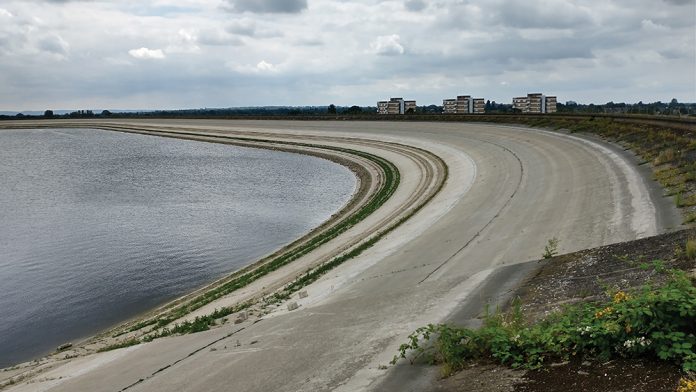Draining one of London’s largest reservoirs for refurbishment – while maintaining water supply and protecting the ecological balance – has been a huge logistical challenge, spanning nearly 12 months. Thanks to meticulous planning, the QEII reservoir project is set to finish ahead of schedule in early spring 2022. Karen Southern follows progress to date.
Thames Water started draining the Queen Elizabeth II reservoir in Walton-on-Thames in April 2021. Over three months, nearly 20,000 million litres of water (equivalent to 8000 Olympic-sized swimming pools) were carefully drained and transferred to the supply network feeding London.
This enabled statutory inspection and maintenance work to start on the 2km of inlet and outlet tunnels which lie 40m beneath a sprawling network of roads, homes and other reservoirs. Intermediate shafts were sunk to provide four points of access in the middle and at both ends of the works.
At nearly 60 years old, the tunnels – constructed from 2.5m diameter precast concrete un-bolted segmental rings – were then strengthened with a reinforced concrete lining to prevent future leakage. But first, several tonnes of silt and tonnes of invasive zebra mussels had to be dug out.
As programme director Rob Keen explained with some understatement: “It is a big deal taking this reservoir out of service for 12 months. QEII is the fourth largest reservoir in west London and supplies 10 per cent of the city’s raw water supply. It’s part of the Hampton and Walton treatment work feeds which serves a third of London… at least two to three million people.
“Having such a major strategic asset out of supply needed a lot of co-ordination, but the tunnel relining work was crucial to guarantee the resilience of our water infrastructure, and it means asset life is ensured for up to another 100 years.”
Rob added: “The reservoir had to be emptied for safety reasons, so its water level was the same as surrounding ground level. This was to ensure that no flooding could occur in the highly unlikely event of a dam breach. As the inlet and outlet tunnels were isolated, they couldn’t drain the reservoir in an emergency.
“Ironically, the civil engineering / maintenance part has almost been the easier aspect. The hard parts were the planning and all the enabling work involved in taking the reservoir out of supply without any impact on customer supplies – that’s been my primary programme management role in this project.”
The revised operating strategy for London focused on establishing different ways to abstract, store, treat and circulate water around the city during the works. Extra treatment works and pumps were brought online, and abstractions from the River Thames were switched, taking less water from the point which normally feeds into QEII, and more from other points up and downstream.
The Environment Agency, DWI, Defra, the GLA, Port of London Authority, Wildlife Trust and other stakeholders, including local residents, have all been regularly briefed throughout because, as Rob pointed out: “This project isn’t just serious about engineering, it’s about the local community and environment too.”
As an important SSSI site lies just across the road, water levels were lowered and held to a depth of six metres to protect birds, fish and other wildlife, while the solar panels that float on top of the reservoir stayed operational throughout. Rob added: “The mudflats were also protected from nesting birds, so there should not be any delays in refilling.”
Work is now complete on the inlet tunnel, and reservoir refilling started mid-November; this could take 8-12 weeks. Parallel maintenance is being done on the outlet tunnel with the aim of returning to normal service by April 2022.
Fortunately, there’ve been no sleepless nights for the team. Rob explained: “The highest risk point was during the summer which traditionally has higher customer demand and lower river abstraction to fill the reservoirs. But in fact, the wetter weather meant very healthy levels of rainfall and river flow. Plus, customer water demand is still suppressed because of the pandemic, particularly in London.
“It’s difficult to judge when and if water usage will rise to pre-pandemic levels. In the meantime, we’re are taking every opportunity to do more maintenance work while customer demand is low, so we are ready for when that return to ‘normal’ occurs.”



